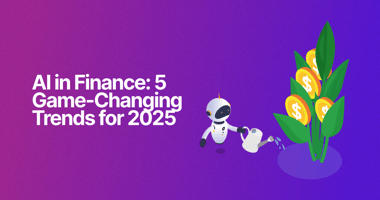If you want to build your own low-code AI tool, try your hand at this Knowledge Base Article...
The Human in the Machine: Ethical Considerations and the Future of AI-powered Customer Service
We asked CX Leader, Michael Mattson, a few questions about his experience with Customer Success. Here’s what we heard:
In today's digital world, how do you cultivate emotional intelligence and empathy within your team to ensure they can connect with customers on a deeper level, even through non-face-to-face interactions?
Michael Mattson: In a digital age where many customer interactions happen through screens, cultivating emotional intelligence (EQ) and empathy within teams is more important than ever. Here are some strategies to help foster these crucial skills:
Lead by Example:
As a leader, modelling empathy and EQ in your own interactions sets the tone for your team. Demonstrate active listening, validate feelings, and show genuine care for both employees and customers. When your team sees these behaviors in action, they're more likely to embody them as well.
Provide EQ Training:
Invest in workshops or courses that specifically teach emotional intelligence and empathy. These trainings can provide practical techniques for reading emotional cues, practicing self-awareness, and responding to others with compassion. Make EQ development a priority and give your team the tools to grow.
Emphasize the Human Connection:
Remind your team that behind every screen is a real person with feelings, needs, and challenges. Encourage them to take a moment before each interaction to humanize the customer in their mind. What might this person be going through? What do they need from us right now? This mindset shift can make a big difference.
Share Customer Stories:
Regularly discuss real customer experiences as a team, both positive and negative. Dissect what went well or poorly in each interaction and brainstorm ways to create more emotionally intelligent responses. Seeing concrete examples of empathy in action (or missed opportunities) is a powerful learning tool.
Practice Active Listening:
Train your team to fully focus on the customer during each interaction. Teach techniques like paraphrasing and reflecting feelings to show the customer they're truly being heard. The better we listen, the more we can empathize and find the root need behind the words.
Allow Space for Reflection:
Build in time for your team to process challenging customer interactions. Give them opportunities to talk through difficult emotions and brainstorm ways to handle similar situations with more care in the future. A supportive team environment fosters the psychological safety needed for growth.
Collect Feedback:
Regularly survey customers on their emotional experience with your team. Did they feel heard, understood, and cared for? Use this feedback to identify areas for improvement and celebrate moments of exceptional empathy. When teams see the direct impact of their EQ, they're motivated to keep strengthening it.
Ultimately, cultivating emotional intelligence and empathy is an ongoing process that requires intention, practice, and reinforcement. By weaving these strategies into your team culture, you build the capacity to create genuine human connections, even from behind a screen. In an age of digital transformation, that just might be the most valuable skill of all.
How do you balance leveraging data and customer insights to personalize experiences while still maintaining a human touch that fosters positive employee experiences (EX) which ultimately translate to better customer experiences (CX)?
Michael Mattson: Balancing data-driven insights with a human touch is crucial for fostering positive employee experiences that ultimately lead to better customer outcomes. Here are some strategies to achieve this balance:
Use Data to Identify Opportunities, but Empower Employees to Drive Change:
Leverage customer insights and data analysis to pinpoint areas for improvement, but involve your team in developing solutions. For example, in my role as Customer Experience Improvement Specialist, I analyzed large data sets to reveal systemic patterns and opportunities. However, I then collaborated with cross-functional teams to identify process gaps and bottlenecks. By engaging employees in the problem-solving process, you not only benefit from their frontline insights but also foster a sense of ownership and empowerment.
Invest in Employee Training and Development:
Provide your team with the skills and knowledge they need to deliver personalized, empathetic customer experiences. This could include training on emotional intelligence, active listening, and communication techniques. In my experience as Manager of Consumer Affairs, I directed a comprehensive training initiative for 50+ Supervisors of Customer Service, focusing on best practices in customer interaction. This investment yielded a 30% increase in team efficiency and 40% decrease in response time. When employees feel equipped and supported, they're more likely to form genuine connections with customers.
Balance Automation with Human Interaction:
Leverage technology and automation to streamline processes and gain efficiency, but don't lose sight of the human element. For instance, as Customer Experience Improvement Specialist, I optimized reporting processes through automation, significantly reducing work-hours. However, I balanced this with implementing a robust customer feedback system to ensure we were still capturing the human perspective. Automation should free up your team to focus on more high-value, personalized interactions with customers.
Model Empathy and Servant Leadership:
As a leader, set the tone by demonstrating empathy, active listening, and a commitment to servant leadership. Regularly engage with your team, provide coaching and mentorship, and create a safe space for them to share challenges and successes. In my various roles, I've prioritized team development, providing hands-on training and guidance to help my employees grow. When leaders model empathy, it trickles down to employee-customer interactions.
Continuously Gather and Act on Feedback:
Regularly seek feedback from both employees and customers to gauge the effectiveness of your efforts. Use this qualitative data alongside your quantitative metrics to gain a holistic view of the employee and customer experience. Involve your team in analyzing this feedback and developing action plans. By showing that you value their input and are committed to continuous improvement, you foster a culture of engagement and customer-centricity.
Ultimately, balancing data and human touch requires a multi-faceted approach. By leveraging insights to drive targeted improvements, investing in employee development, balancing automation with personalization, modeling empathetic leadership, and continuously iterating based on feedback, you can create a virtuous cycle. Engaged employees who feel valued and supported are more likely to deliver exceptional, humanized customer experiences, leading to satisfied customers and a thriving business.
What strategies do you use to gain a deep understanding of your customers' needs and preferences, and how do you incorporate this understanding into your service design and delivery?
Michael Mattson: As someone who has worked extensively in customer experience roles, I've found that gaining a deep understanding of customers' needs and preferences is crucial for designing and delivering exceptional service. Over the years, I've employed a range of strategies to achieve this.
One approach that has been particularly effective is implementing a robust customer feedback system. In my role as Customer Experience Improvement Specialist at USPS, I developed a data-driven method to monitor and evaluate Customer Relationship Management (CRM) software performance metrics, including customer feedback. By regularly collecting and analyzing customer opinions, my team was able to identify pain points, unmet needs, and areas for improvement. We then incorporated this feedback directly into our service design, allowing us to create experiences that truly addressed customer preferences.
Another key strategy is leveraging data analytics to uncover insights. When I was Manager of Customer Experience Local Operation Center, I led an initiative to improve our data input system through validation rules and automation. This increased our data entry accuracy by 32%, which in turn allowed us to trust our data and use it to make informed decisions about service design. I also invested in my team's data analysis and visualization skills, training a team of six employees to efficiently turn raw data into actionable insights.
It's not just about the hard data. Soft skills, like active listening, are equally important. Throughout my various roles, I've prioritized training and mentoring team members on communication techniques. The goal is to fully focus on the customer during every interaction, ask clarifying questions, and reflect back what we've heard to ensure understanding. By truly listening to customers, we can pick up on nuances, read between the lines, and identify unstated needs or preferences.
Creating detailed customer personas based on data, feedback, and frontline observations has also been a game-changer. These personas capture key demographics, behaviors, motivations, and preferences of our main customer segments. By bringing these personas to life and sharing them widely within the organization, we ensure that everyone keeps the customer front and center when designing and delivering service. In my experience, persona development workshops are a powerful tool for aligning teams around a shared understanding of the customer.
Finally, I'm a big believer in continuous testing and iteration. Regularly testing new service designs and features with real customers is essential for validating our understanding of their needs and preferences. This could involve A/B testing, pilot programs, or beta releases to a select group of customers. We gather feedback, analyze results, and iterate based on what we learn. This continuous improvement cycle has been a key factor in the success of the customer experience initiatives I've led.
Ultimately, gaining a deep understanding of customers requires a multi-faceted approach. It's about combining hard data with soft skills, leveraging technology and human insight, and continuously refining our understanding. By employing these strategies consistently, we can design and deliver service experiences that not only meet but exceed customer expectations.
AI integration is rapidly changing the customer experience landscape. Beyond technical considerations, what are your thoughts on the ethical implications and the role of human oversight when integrating AI into customer interactions?
Michael Mattson: As AI rapidly transforms the customer experience landscape, it's crucial that we pause to consider the human impact of this technological shift. While the potential benefits are undeniable, we must also grapple with the ethical implications and ensure that human oversight remains at the forefront.
At the heart of this discussion is the fundamental right to privacy. When we integrate AI into customer interactions, we're often asking people to trust us with their personal data. This is a responsibility that cannot be taken lightly. We must be transparent about how that data will be used and take every precaution to keep it secure. Building and maintaining customer trust depends on it.
But even if we handle data responsibly, there's still the risk of bias creeping into AI systems. These biases, often reflecting societal inequities, can lead to unfair treatment of certain groups. Imagine the frustration and alienation a customer would feel if an AI system discriminated against them. Regular audits and a commitment to fairness are essential to prevent this.
However, AI shouldn't operate in isolation. Human oversight acts as a crucial safety net, particularly in complex or sensitive situations. An AI might be able to efficiently handle a routine inquiry, but when a customer is dealing with a serious issue, they need the empathy and nuanced understanding that only a human can provide. Keeping people in the loop ensures that customers are treated with the respect and care they deserve.
Transparency is another key piece of the puzzle. When customers know they're talking to an AI, it empowers them to make informed decisions about those interactions. Honesty and clear communication foster a sense of trust and collaboration between companies and the people they serve.
Ultimately, as we navigate this new frontier of AI in customer experience, we must never lose sight of the human element. By prioritizing ethics, oversight, and transparency, we can harness the power of AI to enhance rather than replace human connection. It's not just about efficiency; it's about building a future where technology serves people and strengthens the relationships that matter most.
As someone who has worked extensively in customer experience and is passionate about the responsible integration of AI, I believe that addressing the ethical implications and ensuring human oversight are critical when integrating AI into customer interactions.
In my role as President of the Northeast Chapter of the Contact Center AI Association (CCAIA), I'm committed to driving education and collaboration around ethical AI governance best practices. It's crucial that organizations are transparent with customers about when and how they are interacting with AI systems. Customers have a right to know if they are communicating with a machine or a human, and attempting to deceive them can erode trust and damage relationships. This transparency is key to building and maintaining customer trust as we navigate this new frontier.
AI with A Human Touch:
The human touch is often what elevates a customer interaction from adequate to exceptional. While AI can efficiently handle routine queries and tasks, human agents are uniquely capable of expressing empathy, creatively problem-solving, and going above and beyond to delight customers. In my roles, I've always prioritized giving customers a seat at the table and truly understanding their needs. This human-centric approach is essential as we integrate AI into customer interactions.
The Ethical Considerations of Bias:
AI models can sometimes perpetuate or amplify biases present in the data they are trained on, leading to unfair or discriminatory outcomes for certain customer groups. Imagine the frustration and alienation a customer would feel if an AI system discriminated against them.
Privacy and Data Security are Paramount:
AI systems often require access to vast amounts of customer data to function effectively. Having worked with sensitive customer information at USPS, I understand the importance of robust data protection measures and strict compliance with privacy regulations. We must be transparent about how data will be used and take every precaution to keep it secure.
While AI offers great potential to enhance the customer experience, we must never lose sight of the human element. In my role at Walk A Mile CX, I'm helping businesses humanize their customer experiences. I believe the most successful organizations will be those that strike the right balance between leveraging AI's efficiency and preserving the warmth of human interaction. This requires not only technical savvy but a deep commitment to ethics and a people-first mindset.
As we navigate this transformative shift, prioritizing ethics, oversight, and transparency will be key. By proactively addressing ethical implications and ensuring meaningful human involvement, we can harness AI to enhance rather than diminish the customer experience. The goal should be to create a future where AI and human intelligence work in harmony to deliver service that is not only efficient but also deeply empathetic. It's not just about streamlining processes; it's about building trust, fostering genuine connections, and strengthening the relationships that matter most.



